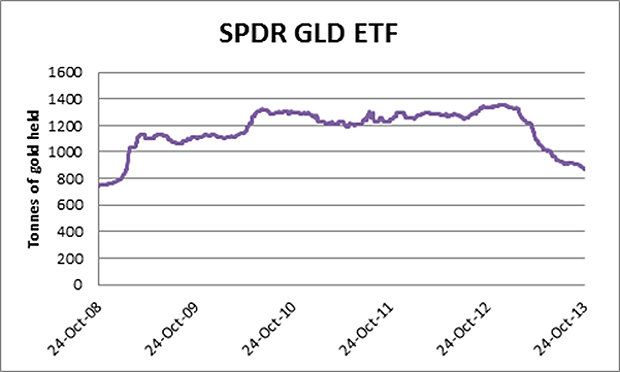
As I’m sure you’re aware, there’s been some interesting activity in the gold market of late. Despite the lack of tapering – and fundamentals screaming for a higher price – progress to date has been somewhat muted. At the close on 1 November, the price reads $1,307.
Needless to say, we’re still contrarian investors. And there are plenty in the market trying to talk the price down. Goldman Sachs recently went out on a bit of limb predicting a fall in the gold price to $1,144 per ounce in 2014. But their rationale for lower prices looks feeble.
It rests on improving US economic data, rising real rates and tapering of quantitative easing (QE). I don’t see any of those things happening (and I don’t think the market does either).
There are now so many elephants in the room we’re starting to run out of space! Soaring demand from China, India and Russia. No tapering of QE on the horizon (in fact, it looks like they’ll probably print more). Falling gold supply. And finally, gold pouring out of the Comex and exchange-traded funds (ETFs).
But the story in gold right now is the delicate balance between demand and supply. And in particular, some recent analysis from Sprott Asset Management that really set the cat amongst the pigeons.
Sprott’s analysis is based on the global supply and demand of gold. Basically, it accuses Thomson Reuters and the World Gold Council (WGC) of understating the gold supply shortfall relative to gold demand. Here is its analysis:
| Supply | Partial year | Annualised | Source |
|---|---|---|---|
| Mine production | 1,383 | 2,765 | GFMS |
| less Chinese domestic production | 270 | 440 | China Gold Association |
| less Russian domestic production | 122 | 183 | WBMS |
| Total mine production excluding China & Russia | 991 | 2,142 | |
| Demand | |||
| Hong Kong net exports to China | 716 | 1,074 | Hong Kong Census |
| Net imports to Hong Kong | 471 | 707 | Hong Kong Census |
| Thailand – net imports | 157 | 313 | UN Comtrade statistics |
| Turkey – net imports | 124 | 248 | UN Comtrade statistics |
| India – net imports | 551 | 1,102 | UN Comtrade statistics |
| Central Banks – change in reserves | 216 | 431 | IMF |
| Other countries – jewellery, coin and bar demand | 655 | 1,309 | GFMS |
| Total demand | 2,890 | 5,184 | |
| Other sources of supply | |||
| Gold recycling | 672 | 1,344 | GFMS |
| ETF outflows | 724 | 917 | Bloomberg |
Source: Sprott Global
This is incredible. It’s estimating total demand for this year of 5,184 tonnes against mine supply (excluding China and Russia who don’t export any of their production) of just 2,142. Adding back scrap and ETF outflows, we get to 4,403 tonnes – which still leaves a chunky 781-tonne shortfall.
In an open letter to the World Gold Council, Sprott said “demand statistics reported by the World Gold Council… consistently misrepresent reality, mostly with regard to demand from Asia.”
Now, clearly the World Gold Council and Thomson Reuters GFMS aren’t happy. Here’s what they had to say:
“The use of import data as a proxy to measure gold demand is somewhat simplistic and does not take into account factors such as round-tripping and stocking/destocking… To effectively measure gold demand, a more detailed holistic analysis is required.”
Thomson Reuters GFMS said it stood by its 2013 supply and demand gold estimates. The figures were “based on highly detailed on-the-ground analysis by a large team of analysts based around the world and which are figures supported by experts at the World Gold Council”.
I’m not close enough to the information to decide who’s right on this. But it’s a real eye-opener to read a respected source like Sprott calling the WGC’s credibility into question. Anyway, form your own view.
The gold ATMs
To meet soaring demand, the gold obviously has to come from somewhere. A large chunk has been withdrawn from ETFs, but this isn’t sustainable. ETFs have been used as a sort of cash point machine to prop up the shortfall in supply. Call it low-hanging fruit.
Here’s a graph showing the movement of physical gold from SPDR GLD (the largest physically backed gold ETF in the world) over the past five years:
Source: SPDR GLD
Holdings have plummeted from 1,353 tonnes on 10 December 2012 to 872 tonnes on 25 October 2013 – a drop of 481 tonnes.
If this decline continues, then this route to physical gold won’t be around for very long. With gold increasingly moving east and falling into the strong hands of those with no interest in selling, and more importantly, no need to sell it, it’s very difficult to see how the market will cope with ever increasing demand.
I know I keep banging on about it, but when you have a material lack of supply and rising demand, the price is only going to go one way.